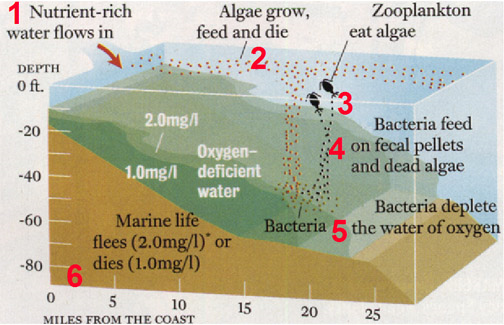Scientists are expecting an average, but still large, hypoxic or “dead zone” in the Gulf of Mexico this year, and a slightly above-average hypoxic zone in the Chesapeake Bay.
NOAA-supported modeling is forecasting this year’s Gulf of Mexico hypoxic (very low oxygen) zone to cover an area ranging from 4,633 to 5,708 square miles (12,000 to 14,785 square kilometers) or about the size of the state of Connecticut.
The Gulf of Mexico prediction is based on models developed by NOAA-sponsored modeling teams and individual researchers at the University of Michigan, Louisiana State University, Louisiana Universities Marine Consortium, Virginia Institute of Marine Sciences/College of William and Mary, Texas A&M University, and the U.S. Geological Survey (USGS), and relies on nutrient loading estimates from the USGS. The models also account for the influence of variable weather and oceanographic conditions, and predict that these can affect the dead zone area by as much as 38 percent.
A second NOAA-funded forecast, for the Chesapeake Bay, predicts a slightly larger than average dead zone in the nation’s largest estuary. The forecast predicts a mid-summer low-oxygen hypoxic zone of 1.97 cubic miles. Because of the shallow nature of large areas of the estuary the focus is on water volume or cubic miles, instead of square mileage as used in the Gulf.
The Chesapeake Bay prediction is based on models developed by NOAA-sponsored researchers at the University of Maryland Center for Environmental Science, University of Michigan, and again relies on nutrient loading estimates from USGS. The confirmed size of the 2014 Gulf hypoxic zone will be released in late July, following a monitoring survey. Similarly, the actual size of the Chesapeake Bay hypoxic area will be announced in the fall.

The dead zone in the Gulf of Mexico affects nationally important commercial and recreational fisheries and threatens the region’s economy. The Chesapeake Bay dead zones, which have been highly variable in recent years, threaten a multi-year effort to restore the water and habitat quality to enhance its production of crabs, oysters, and other important fisheries.
“We are making progress at reducing the pollution in our nation’s waters that leads to ‘dead zones,’ but there is more work to be done,” said Kathryn D. Sullivan, Ph.D., under secretary of commerce for oceans and atmosphere and NOAA administrator. “These ecological forecasts are good examples of the critical environmental intelligence products and tools that NOAA provides to interagency management bodies such as the Chesapeake Bay Program and Gulf Hypoxia Task Force. With this information, we can work collectively on ways to reduce pollution and protect our marine environments for future generations.”
NCCOS has been funding the development of hypoxia forecasts in the Gulf of Mexico since 1990 and in the Chesapeake Bay since 2005. This is the first year that NCCOS is using the results of three separate models to develop integrated forecasts for both the Gulf and the Bay.
For more information, contact Alan.Lewitus@noaa.gov.
